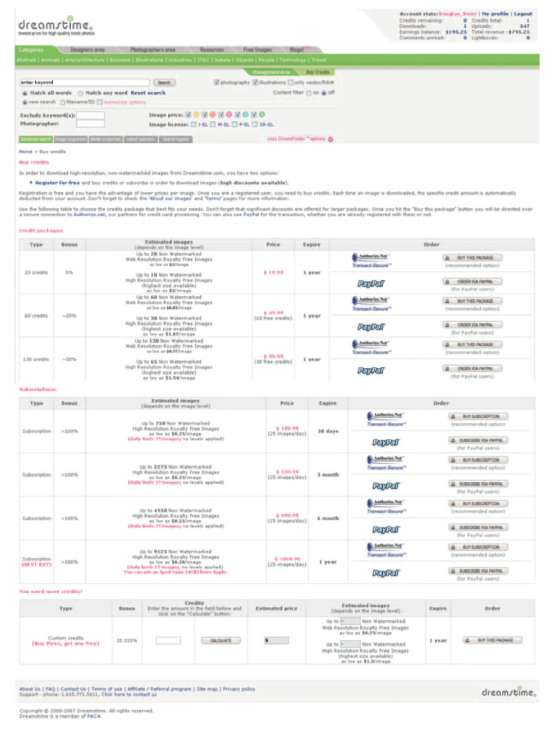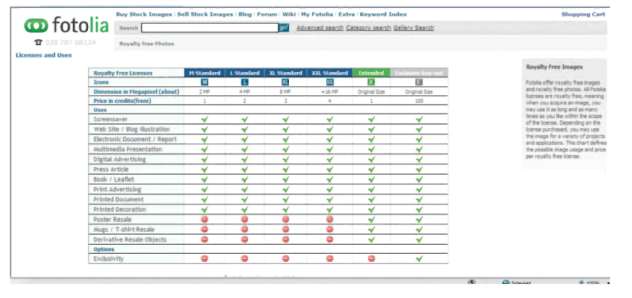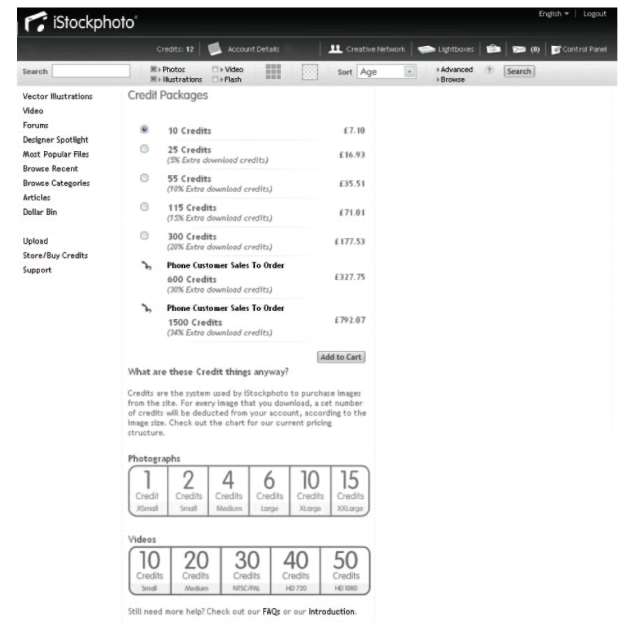CHAPTER 2
How to Make Dollars from Cents
The unique selling point of the microstocks is their low pricing. This, in turn, means that the commission payable to the photographer can be as low as $0.25 per image sale, although, in practice, this figure is at the bottom end of a range that can go a lot higher. With such low commissions it might seem that it will be impossible to earn “real” money. That is a view shared by many traditional stock photographers. In fact, discussions on the subject can become quite heated!
Yet, despite this, I have now reached sales from a portfolio of five microstock sites of around $750 per month in around 2 years from a standing start. That’s useful money in anyone’s language, particularly as I am not shooting stock full time. But this is a far from exceptional result (see Chapter 10); the truth is I could have earned a lot more if I had not been so darn busy with other projects. And the income is increasing.
Now I believe I have some talent as a photographer, even if I am not Ansel Adams. But—and this is a critical point—in many ways, the demands of the microstock libraries are very different from the kind of camera club success stories keen amateurs might be familiar with.
For a modern-day microstock phenomenon, consider the case of Yuri Arcurs (see his site at www.arcurs.com), who claims to sell over 400,000 images a year (Figure 2.1). He has two assistants who help in the production and upload process, and he concentrates on popular themes. He is a great microstock success story. If you want to mimic that level of success, it will take a lot of time and effort. But the point is that it can be done. Follow this advice: forget fine art and learn fine business if making money from the microstocks is your goal.
NO PAIN, NO GAIN
Everyone who sends work to the microstocks undergoes a steep and psychologically painful learning curve (and I do mean everyone, be

FIGURE 2.1 One of the world’s most successful microstock photographers is Yuri Arcurs from Denmark. Here is one of his classic business images, “Strength in Numbers.” © Yuri_Arcurs/iStockphoto
they full-time professionals, keen amateurs, or casual snappers). The problem is that the microstocks impose high technical standards. New microstock subscribers (even those with previous experience of selling work through traditional stock libraries) do not always fully appreciate what these technical standards are or what they need to do to meet them. This can put photographers off before they have given the microstocks a chance. Photographs are rejected—How dare they!—for a whole range of problems that might not show up in print or even on screen if you don’t know what to look for. Rejections for noise, dust blobs, poor composition, bad lighting, and a myriad of other defects reduce the snapper to table-chewing frustration and anger. (Believe me, I know. I’ve been there.) Some poor souls give up before they get going, which is a shame because by following the guidance I give in this book, your chances of success should be radically improved.
My main purpose with this book is to fast track you to success with the microstocks. Learn from the experience of myself and others. Don’t repeat common mistakes.
As far as I am concerned, the microstock case is proven. The micro-stocks are an open invitation to anyone with a modicum of talent and a little spare time to earn significant extra cash. With real dedication, perhaps you can end up making a full-time living from the microstocks.
Check out Figure 2.2. This image is one of my best sellers on the microstocks. In 1 year since first uploaded, it has been downloaded from iStockphoto alone more than 700 times, earning over $290 in commission for me, the photographer, from just that one library. It has done very well elsewhere too, and sales continue at an impressive monthly rate. You may think that it is a studio shot taken with a megabucks camera and lighting. Wrong! It was taken on a 6-MP Fuji F10 compact camera, with a little tender loving care applied in

FIGURE 2.2 “Modern Office Reception.” This photo more than paid for the camera that took it. © Douglas Freer/iStockphoto
Photoshop CS2 (noise reduction, perspective correction, copyright logo removal). That one shot has more than paid for the camera that took it. You don’t need expensive equipment (although good equipment helps); you just need to know how to use what you have. Who said you can’t earn dollars from cents?!
In Chapter 3, we’ll consider why this image has been so successful, what images are generally likely to be winners, and what images may be losers. But next up in this chapter, we consider the different types of microstock sites and their pros and cons, with reference to specific examples.
SALES MODELS: THE CHOICES
The way the microstocks sell images is highly relevant to both photographers and photo buyers. There are broadly three different standard microstock sales models to consider:
- Credit package (single sale) sites, where buyers purchase images singly, usually using credits purchased in advance
- Subscription sale sites, where buyers purchase a subscription and can then download a set number of images overall and per day during the subscription period
- Hybrid sites, which combine the best of both worlds
Let’s look in more detail at how four of the leading microstock libraries—Dreamstime, Shutterstock, iStockphoto, and Fotolia—sell images. I have chosen these libraries because they are among the largest and they have proven track records, but that is not to say other libraries are not as good or better choices for you. A list of leading microstock sites is presented in Appendix 1 so that you can compare them online. Please bear in mind that these packages are liable to change and are provided as examples only.
DREAMSTIME
We’ll start with Dreamstime (www.dreamstime.com), a hybrid library, offering buyers the choice of single-image downloads paid for with credits or a subscription. Dreamstime started as a royalty-free stock photography Web site in 2000, selling images on compact discs. It relaunched in March 2004 as a microstock site, and it has now grown to become one of the larger and more successful sites. As with all microstocks, it relies upon contributing photographers to provide the content through the online Web site and FTP upload, with a present minimum file size of 3 MP.
At the time of this writing, Dreamstime offers two purchase options. You can buy credit packages of between 20 and 130 credits, starting at $19.99 for a 20-credit package and ending at $99.99 for 130 credits (Figure 2.3). There is also a higher discount available using

FIGURE 2.3 The Dreamstime credit purchase page from my account, January 2007.
the custom order tool available for packages of more than 160 credits. Alternatively, you can become a subscriber by purchasing a subscription package that allows for as few as 30 days and 750 images to 1 year and 9,125 images, in each case with a 25-image-per-day download limit.
Per-image pricing is dependent upon the resolution required, with prices increasing for larger, higher-resolution images and the “level” of the image (higher prices charged for the more popular images). This translates to higher commissions for photographers. For further information, see http://www.dreamstime.com/sellimages.
If you look at the Dreamstime pricing in detail, it appears to favor subscription downloads, where per-image prices are at their lowest. But, according to Serban Enache, chief executive officer (CEO) of Dreamstime, the credit packages are in practice the more popular choice with buyers.
SHUTTERSTOCK
Shutterstock (www.shutterstock.com) is a pure subscription site, offering packages starting at 1 month with a maximum of 25 downloads per day for $159.00 to 1 year with a maximum of 25 downloads per day for $1,599.00. It is arguably the most successful subscription site, and if you are thinking of sending some of your work to the microstock image libraries, my advice is to put Shutterstock at the top of your library list.
We will continue to adjust our payouts to match the pace of business. Our photographers are our greatest asset, and we know it.
Jon Oringer, CEO, Shutterstock
Unlike Dreamstime, at Shutterstock all image sizes are the same price and so are commission payments to photographers—$0.25 per download for junior photographers and $0.30 per download for more senior photographers with more sales ($500 worth in commission, to be precise). Some photographers deliberately send Shutterstock smaller file sizes only in the belief that this will force buyers to find big files at other sites and pay more for the higher-resolution sizes. I’m not sure this is a sensible use of time and effort, and I would advise against trying to beat the system this way. Go and shoot more stock instead!
Shutterstock is run by entrepreneur Jon Oringer. He has made Shutterstock the yin to iStockphoto’s yang. If you submit work to iStockphoto and Shutterstock, you have bagged what many would regard as the best single sale and the best subscription site, a great starting point in your microstock photographic career. Shutter-stock advertises extensively and generates a considerable amount of user loyalty through its active online forums that are not too aggressively policed.
Part of Shutterstock’s success seems to be linked to the sheer simplicity of its site. Shorn of fancy fripperies, it is seldom off-line and is well regarded among microstock photographers. Some other sites could learn a lesson or two from this no-frills approach. Speaking as a photo buyer as well as photographer, I know how easy it is to jump to another library if my first choice is off-line. Keep it simple, keep it online!
For more information on current subscription prices at Shutterstock, visit http://www.shutterstock.com/subscribe.mhtml (Figure 2.4).
FOTOLIA
Fotolia (www.fotolia.com) is a credit package (single-sale) site. It sells credit packages ranging from $10 to $2,000. Images are purchased for download using these credits, with pricing based on image size (resolution) and, to a lesser extent, usage.
Fotolia also claims to be the biggest site, although this is disputed by some, including Shutterstock. Frankly, it doesn’t matter much as all the major sites are enjoying rapid growth, but Fotolia’s growth does seem to have outstripped that of other libraries. A nice touch offered by Fotolia is that you can see who has downloaded your images, something not offered by most other major sites. Fotolia also has a strong presence in the European market, possibly more so than the other leading microstocks, where North American sales dominate.
For more information, on UK Fotolia pricing, visit http://www.fotolia.com/Info/ Pricing, with alternative pages for other currencies (Figure 2.5).
iSTOCKPHOTO
iStockphoto (www.istockphoto.com) is the “daddy” of the microstock sites, the site that began the microstock revolution and that many would say has stayed at the top of the pile ever since. It sells credit packages from 10 to 300 credits online (Figure 2.6), with larger packages available over the phone. At the time of this writing, prices are under review, but it is fair to say that iStockphoto aims for the “premium” end of the microstock market, assuming that premium microstock is not an oxymoron!
Photographs cost from one credit for images with very low Web resolution to 15 credits for extra-large files, with a starting price of $1.30 per credit and discounts for quantity purchases. Contributing photographers can cash in earnings for credits, continuing the original philosophy behind iStockphoto as a community of artists and designers.

FIGURE 2.4 Shutterstock’s subscription purchase plan page from mid-2007.

FIGURE 2.5 Screen capture of Fotolia’s image licensing and pricing.
SUMMARY
Apart from the “big four,” there are a number of other microstock sites, but all work along similar lines. You should check out each site for current pricing information and commission levels. What really matters is sales performance.
When tracking sales over time, it does seem that the subscription-based sites such as Shutterstock tend to favor newer images. Conversely, in the single-sale libraries such as iStockphoto, it can take some time before an image accepted and added to the library sells for the first time. Clearly, the pressure is on anyone whose subscription limit is about to expire to download whatever is available, just in case it is useful. It is better to have an image of limited use than nothing at all for your money. It is a bit too simple to leave it at that; other factors are in play, such as different search engines, target markets, and so on. Nonetheless, my advice is to make sure you send your work to both subscription-based and single-sale libraries if you want to maximize your market exposure and, thus, sales.
ROYALTIES AND LICENSES, OR “WHERE IS THE CASH?”
If you are a photographer, you are of course interested in the commission payments you will receive if (or, more probably, when) your work sells. Here we briefly consider the other pros and cons for the current four leading microstocks.

FIGURE 2.6 iStockphoto’s credit page. © iStockphoto 2007
All stock photo images sold are sold subject to terms contained in a license the buyer agrees to at the point of sale. That license grants the buyer certain rights that govern how the image can be used. Standard licenses tend to restrict the use of images to print runs not exceeding 250,000 or 500,000 and limit the use of the image in certain ways. For example, a standard license might allow the use of the image on a Web site, up to a certain resolution, but not in a Web template or as an item for resale, such as a mug or mouse pad. Some uses require the purchase of an extended or enhanced license; this costs more money and therefore nets a bigger royalty for you, the photographer.
So, let’s revisit our “top four” libraries and see where the cash is coming from.
DREAMSTIME
Dreamstime claims that its royalties are the best in the industry, at least in terms of percentages. For each sale, the photographer receives a commission of 50%. Images offered exclusively through Dreamstime receive a 60% commission, while exclusive photographers enjoy an additional bonus of $0.20 for each approved submission. However, Dreamstime boss Serban Enache points out that if you add in the bonuses that Dreamstime supports, the real royalty figure is closer to 80%, which is claimed to be the best in the industry. To qualify for a payout, Dreamstime needs to owe you at least $100, a figure you should soon reach if you submit a reasonable amount of work to it.
As prices for successful images increase incrementally, your commission in absolute terms can also increase. The downside of Dreams-time is the need to maintain online 70% of new uploads for 6 months. Files older than 6 months can be deleted at any time. This 6-month retention for new uploads may be a nuisance if you should decide you want to pull your work from Dreamstime for any reason, for example, if you want to accept artist exclusivity at iStockphoto. I know I objected to the idea when it was first introduced, but it should not be a problem for most people.
You can make more money by opting in to Dreamstime’s extended-license regimen. The standard royalty-free license covers most uses the average buyer is likely to need, such as in Web sites, magazines, newspaper, books, flyers, or any other advertising and promotional material, in either printed or electronic media, but there are some restrictions that require the purchase of an extended license.
Dreamstime’s “U-EL” extended license removes the single-seat restriction (i.e., one-person use only); the “I-EL” extended license extends the number of copies, such as a print run, from 500,000 to 2,500,000; the “W-EL” extended license allows your images to be used in Web templates, screen savers, e-cards, PowerPoint presentations, and cell phones; and the “P-EL” extended license covers physical items for resale, such as t-shirt graphics, greeting cards, and mugs. Finally, there is the option to sell all rights (“SR-EL”).
These extended licenses are relatively expensive for buyers, particularly the SR-EL option—but think carefully before you opt for the SR-EL option as this is a complete buyout of all your rights, not something I’d recommend without contemplation. You, the photographer, set the buyout price.
FTP upload is available but is rationed so that those photographers with low acceptance ratios are excluded.
Dreamstime has recently undergone a facelift, greatly improving the appearance of the site. It is now one of the nicest around, in my view. It has some neat features, including an “In the News” section and blogs, which Serban hopes will help increase the sense of community at Dreamstime. Dreamstime certainly deserves its place at the micro-stocks’ top table.
SHUTTERSTOCK
Shutterstock likes to keep things simple (simple sells in more ways than one), and that applies to its commission structure. The standard commission paid for each sale is $0.25, but from May 1, 2007, Shut-terstock increased royalties to $0.30 per sale if you have at least $500 in earnings. That’s pretty much it for photos.
Shutterstock offers standard and “enhanced” licenses, with the former being perhaps a tad more restrictive than that at Dreamstime, with a 250,000 print run restriction. Shutterstock conveniently has a comparison page to show the differences between its standard and enhanced licenses at http://www.shutterstock.com/license_comparison.mhtml. There is, at the time of this writing, no complete rights buyout option advertised.
It is difficult to audit value with Shutterstock because there are no statistics as to the average number of images downloaded by subscribers. Consider as an example someone who purchases a subscription with Shutterstock for, say, 3 months at $600, with a total daily download limit of 25 and a monthly limit of 750; how many images does that subscriber actually download? I doubt it’s the maximum of 2,250 over 3 months, which would equate to $675 in commission payable at the top $0.30 rate. More likely, it is around half that number or less—so an educated guess is that you, the photographer on top rate, would receive around 50% commission. If correct (and I make no pretence at being a math genius), this is not too bad. Shutterstock is one of the top “must subscribe to” libraries, in my view—proof, if needed, that you can make dollars from cents.
Shutterstock’s nice, clean site is appealing to those who just want to get on with business, and their FTP upload option helps to make life easy for photographers who want to upload in bulk.
FOTOLIA
Fotolia’s commission structure is pretty complex, with a number of variables. The minimum commission is 33% of the sales price for a nonexclusive image and 50% of the sales price for an exclusive image. There is no artist exclusivity option on Fotolia.
The percentage commission increases with the photographer’s ranking, which is based on the total number of downloads. There are eight levels, ranging from White for a beginner with fewer than 100 downloads to Diamond for a photographer with more than 500,000 downloads. The percentage commission jumps by 2% for each level, reaching a maximum of 47% at Diamond level. At the time of this writing, no one has reached Diamond level on Fotolia. These percentages are scaled up for images offered exclusively; add 7% to each level.
Another factor is the image size, with the number of credits required to buy an image increasing by size, from one for small through five for XXL, five for vectors, and more for extended licenses.
There is an FTP upload option available.
Fotolia’s strong presence in the European market is an undoubted benefit to any photographer looking to maximize his or her portfolio’s exposure to a broader range of buyers. Fotolia has a local presence in eight countries (United States, United Kingdom, France, Germany, Spain, Italy, Brazil, and Portugal). It also offers Web sites, key wording, and customer support in six languages (English, Spanish, French, German, Italian, and Portuguese). One of the benefits is that a photographer can upload and key word images in his or her native language, and, upon acceptance, the key words are automatically translated into all six languages supported on Fotolia.
Currently, Fotolia has undergone a major database redesign intended to increase its speed. There have been some spin-off problems, but it is getting back to normal now. The site is less “tight” in appearance than Shutterstock’s site, and the Fotolia menu layout is, I think, frankly bizarre. But Fotolia is a site on the way up, with a particularly strong European focus, and it has been rated by none other than Bruce Livingstone of iStockphoto as a threat. Definitely a site to watch.
iSTOCKPHOTO
Last but not least in this section, we come to iStockphoto. For many, iStockphoto is a top earner, but it has a very controversial artist exclusivity option that divides the standard, nonexclusive photographer, who receives a fixed commission of 20% (yes, you read that right, just 20%), and exclusive photographers, who receive up to a maximum of 40% commission when they hit 25,000 downloads.
iStockphoto is very keen to secure your services as an exclusive photographer. It operates a “canister” reward system that ranks photographers by the number of downloads they have had from their portfolio. For nonexclusive photographers, these canisters (which appear by your name on the site) are simply status symbols, but for exclusive photographers, they govern the percentage commission you receive. Here is a list of the current photographer canister rankings, with the exclusive commission rates in parentheses (you are eligible for exclusivity at 250 downloads, or the Bronze canister level): 0–249 is White, 250–2,499 Bronze (25%), 2,500–9,999 Silver (30%), 10,000– 24,999 Gold (35%), 25,000–200,000 Diamond (40%), and 200,000 Black Diamond (no change).
Make no mistake, iStockphoto is a great choice for inclusion in your portfolio of microstock libraries, but I cannot help thinking how much better it feels to be earning 50% commission or more from other sites, a figure even iStockphoto exclusives at the top rate do not receive. Twenty percent for nonexclusive photographers is too low, and I believe it will have to be raised as iStockphoto comes under increasing competitive threat from other microstock libraries. There is also an extended license option available.
Like Fotolia, iStockphoto has gone international, with the ability to choose which language you would like your Web site to be displayed in, automatic key word translation, and a choice of currencies for payment.
Presently, there is no FTP upload for photographers; instead, there are third-party bulk upload alternatives. Otherwise, you have to submit images one at a time, which is time consuming. iStockphoto has an outstanding, well-designed site, full of content, with carefully monitored forums that are best used for technical queries. Any significant criticism is usually deleted—use the independent forums for that. It also runs events for its photographers called “istockalypses,” where you turn up and shoot models and places and meet other iStockphoto photographers.
My concluding view of iStockphoto is that it’s a great site, superbly designed and run, but with commissions that are too low even for exclusive photographers (and absurdly low for nonexclusive photographers) and a culture that verges on the fringe of a religious cult. A site to be admired and used, but (save for a few insiders) probably not loved.
SUBMISSION STRATEGIES
The four microstock examples I have used stand out as among the top performers from my personal research, but there are other libraries that are also worth a look. You will find a list I have compiled in Appendix 1. I strongly recommend you check out their terms for yourself.
Broadly, there are two basic strategies, and you need to consider which is best for you. Either you spread your work around a number of different libraries to maximize your market exposure, or you go exclusive with one library and put all your eggs in that one basket. In the case of iStockphoto, it’s all or nothing. As I have detailed above, iStockphoto offers up to double the commission rate for exclusive images, but that rate rises to only 40% after 25,000 downloads and you can only sell images exclusively through iStock-photo if you are artist exclusive—meaning that you cannot sell any royalty-free work though other sites. (If you do and you are found out, iStockphoto will probably cancel your contract altogether.) You can still offer different work on traditional licensed terms to other libraries.
Some of the most successful microstock photographers are artist exclusive on iStockphoto (Figure 2.7). One reason for this is that those photographers have been with iStockphoto since the early days, before there was any serious competition. It made more sense to go exclusive with iStockphoto at a time when they dominated the market and the additional commissions available through exclusivity would blow away any money they could make elsewhere. The market has matured a lot in the past 2 years, so there is now more choice.
There are some very successful exclusive artists making good money on iStockphoto, but there are obvious risks in putting all your money metaphorically on red 16. It’s better, in my view, to spread your work through at least four sites.
The following summarize my main points:
- You can and (unless you choose artist exclusivity with iStockphoto) you should spread your work around at least four microstock agencies; doing so spreads the risk and increases your exposure to different types of buyers.

FIGURE 2.7 “Wishes,” a deservedly popular image shot by exclusive iStockphoto photographer Eva Serrabassa, aka “caracterdesign.” © Eva Serrabassa/iStockphoto
- Make sure the libraries you choose include single-sale and subscription-based sales models as they attract different buyers.
- Familiarize yourself with the commissions structure of each library.
In the next chapter, we will look more closely at what sells and what does not—and why.
